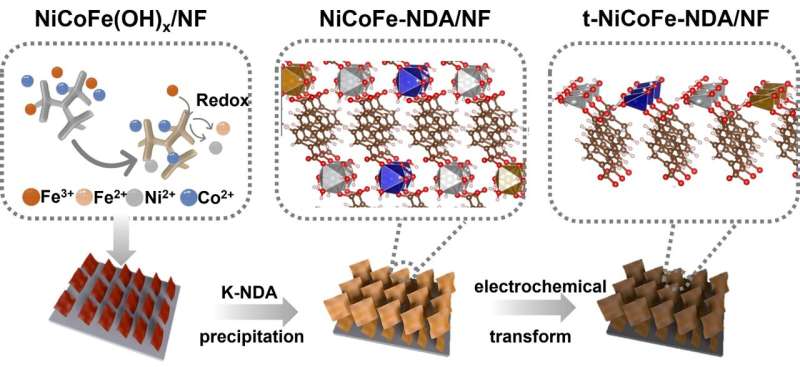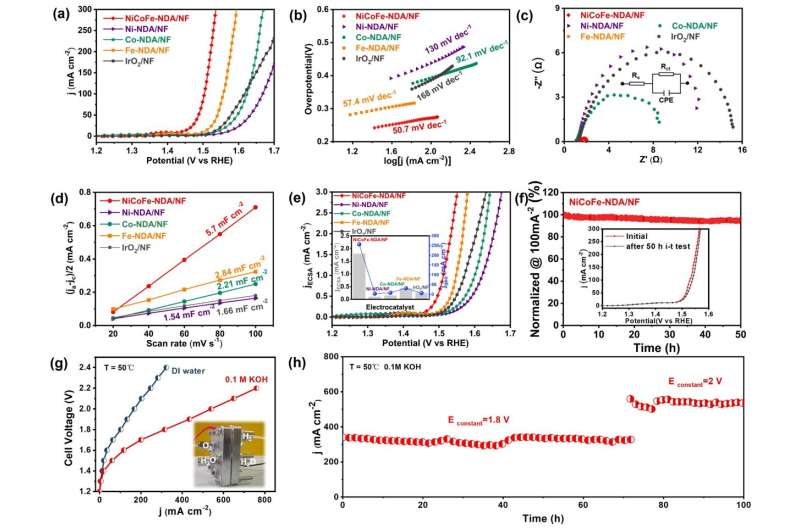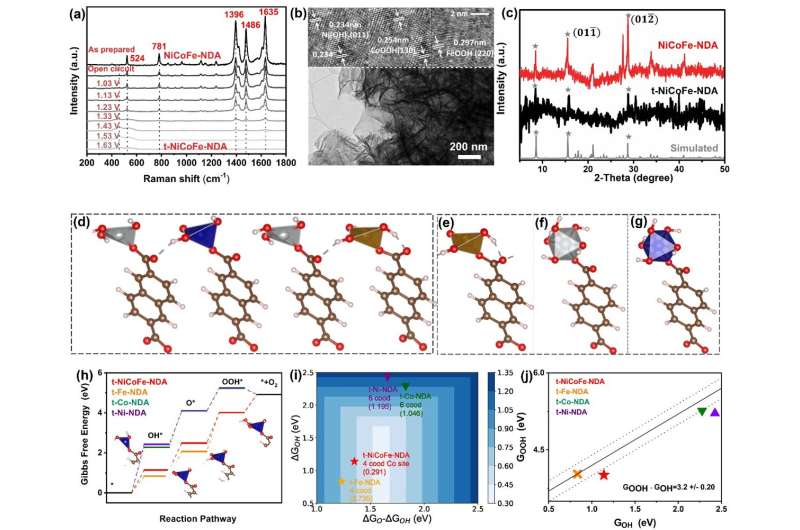Schematic illustration of the formation and transform process of NiCoFe-NDA/NF. Credit: SICCAS
Using a simple redox-precipitation approach, a research team has recently reported their synthesis of ultrathin NiCoFe-NDA (NDA=2,6-naphthalenedicarboxylic acid) nanosheets for high efficiency oxygen evolution reaction (OER) in anion exchange membrane electrolysis (AEMWE). Related results were published on Energy & Environmental Science.
"Compared with monometal (Ni/Co/Fe)-NDA/NF, the NiCoFe-NDA/NF electrode exhibits a much higher OER activity and stability, which even exceeds the benchmarked IrO2 catalyst," said Prof. Wang Xianying from the Shanghai Institute of Ceramics of the Chinese Academy of Sciences (CAS), who led the team.
Developing AEMWE is promising for industrial hydrogen production. However, its slow and complex kinetics of anodic OER largely determines the energy consumption for overall water electrolysis. Currently, the Ir and Ru-based noble metals composites (e.g., RuO2 and IrO2) show high catalytic activities for OER, but the high cost, scarcity, and poor stability restrain their commercially large-scale applications.
Benefiting from highly dispersed active sites, defect-rich edges, abundant open channels, and nanometer thickness, metal-organic frameworks (MOFs), organized by the periodic coordination of metal nodes/clusters with organic ligands, have demonstrated promising electrochemical catalytic activities. However, these MOFs systems reported so far still bear intrinsically low activity and poor stability, becoming a significant bottleneck limiting their direct utilization in the OER electrocatalysis.
Water oxidation performance of NiCoFe-NDA and its performance in anion-exchange membrane water electrolysis. Credit: SICCAS
Introducing heteroatom units in a primitive MOF nanostructure would an effective strategy to address these issues. It can regulate intrinsic charge ordering to optimize the electronic structure of the host metal, resulting in the enhancement of catalytic performance, according to the researchers.
In situ spectroscopy combined with theoretical calculations to illustrate the water oxidation; conformation of NiCoFe-NDA and the study of the water oxidation mechanism. Credit: SICCAS
In this work, the NiCoFe-NDA/NF suffered a topotactical transformation and surface reconstruction. The inherited unsaturated coordination environment and trimetal coupling effects were proved to be positive for enhancing the OER performance.
This work not only demonstrates an ideal platform for the correction of multi-metal coordination with water oxidation performance in organic-inorganic hybrid materials, but also provides a highly promising electrocatalyst for water oxidation and other related energy technologies.
More information: Kaihang Yue et al, In situ ion-exchange preparation and topological transformation of trimetal–organic frameworks for efficient electrocatalytic water oxidation, Energy & Environmental Science (2021). DOI: 10.1039/D1EE02606B
Journal information: Energy & Environmental Science
Provided by Chinese Academy of Sciences


























